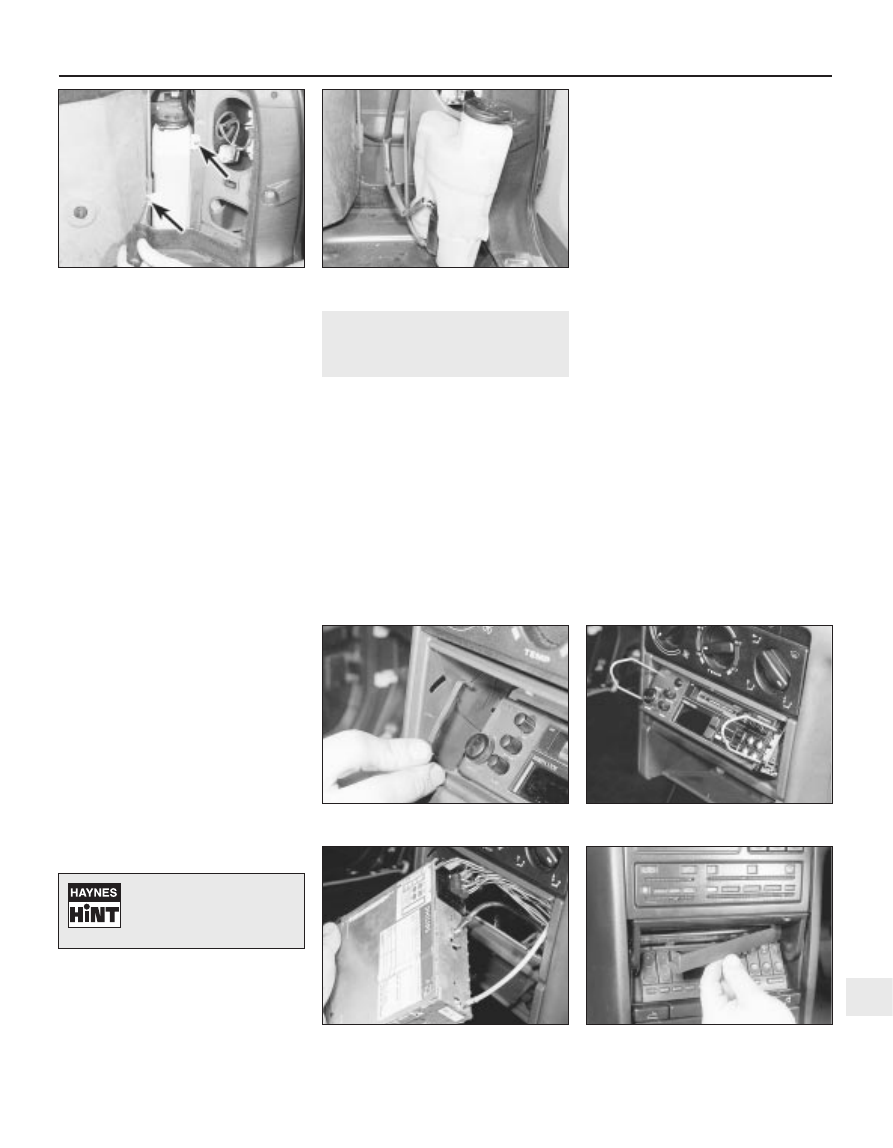содержание .. 58 59 60 61 ..
Peugeot 405. Manual - part 60

Tailgate washer fluid reservoir
6 Disconnect the battery negative lead.
7 Open the tailgate, then turn the securing
clip and open the access panel at the right-
hand corner of the luggage compartment for
access to the reservoir.
8 Remove the two securing screws, then lift
out the reservoir (see illustrations).
9 If the reservoir still contains fluid, empty out
the contents into a container, then disconnect
the wiring plug and the fluid hose from the
pump, and withdraw the reservoir.
10 Refitting is a reversal of removal.
Windscreen/headlight
washer pump
Note: Prior to removing the pump, empty the
contents of the reservoir, or be prepared for
fluid spillage.
11 Disconnect the battery negative lead.
12 Disconnect the wiring connector and the
fluid hose from the pump, then carefully ease
the pump out of its sealing grommet in the
reservoir.
13 Refitting is a reversal of removal.
Tailgate washer pump
14 Disconnect the battery negative lead.
15 Remove the reservoir as described
previously in this Section.
16 Disconnect the wiring connector and the
fluid hose from the pump, then carefully ease
the pump out of its sealing grommet in the
reservoir.
17 Refitting is a reversal of removal.
Tailgate washer jet
18 Pull the washer jet from the rear of the
tailgate and disconnect the fluid hose.
19 Refitting is a reversal of removal.
20 Radio/cassette player -
removal and refitting
2
Radio/cassette player
with DIN fittings
Removal
1 Disconnect the battery negative lead.
2 Carefully prise out and remove the small
plastic trim panels at each side of the
radio/cassette player (see illustration).
3 Insert the removal tools into the holes
provided at each side of the unit, until they
lock into position. This will release the
securing clips (see illustration).
4 Using the tools, pull the unit forwards from
the housing, and disconnect the wiring
connectors and the aerial lead (see
illustration).
5 Withdraw the unit from the facia.
6 Note that some units may have a bracket
and rubber buffer fitted to the rear panel. If a
new unit is being fitted, transfer these
components to the new unit. The buffer sets
the depth of the unit in the housing, and
prevents the security cover fouling the
cassette during insertion and ejection. These
parts are available from dealers if they are not
fitted.
Refitting
7 To refit the unit, reconnect the wiring plugs
and the aerial lead, and push the unit into
position until the securing clips lock. Ensure
that the wiring harness and aerial lead are
routed so that they cannot rub against the unit
casing.
8 Refit the plastic covers to each side of the
unit, and reconnect the battery negative lead.
9 Where applicable, to activate the unit, enter
the security code in accordance with the
manufacturer’s instructions.
Radio/cassette player
with “Peugeot” fixings
Removal
10 Disconnect the battery negative lead.
11 Open the radio/cassette player cover
panel.
12 Working at the top of the unit, carefully
prise off the trim panel to expose the two
holes provided for the removal tools (see
illustration).
13 Two removal tools will now be required.
These tools can be made by cutting a
standard DIN radio/cassette player removal
Body electrical system 12•17
20.2 Remove the plastic trim panels from
the sides of the radio/cassette player . . .
20.12 Prise the trim panel from the top of
the radio/cassette player
20.4 . . . and withdraw the unit
20.3 . . . then insert the removal tools . . .
19.8b . . . and lift out the tailgate washer
fluid reservoir
19.8a Remove the two securing screws
(arrowed) . . .
12
Tie a length of string to the
end of the fluid hose to
prevent it from falling back
into the tailgate.